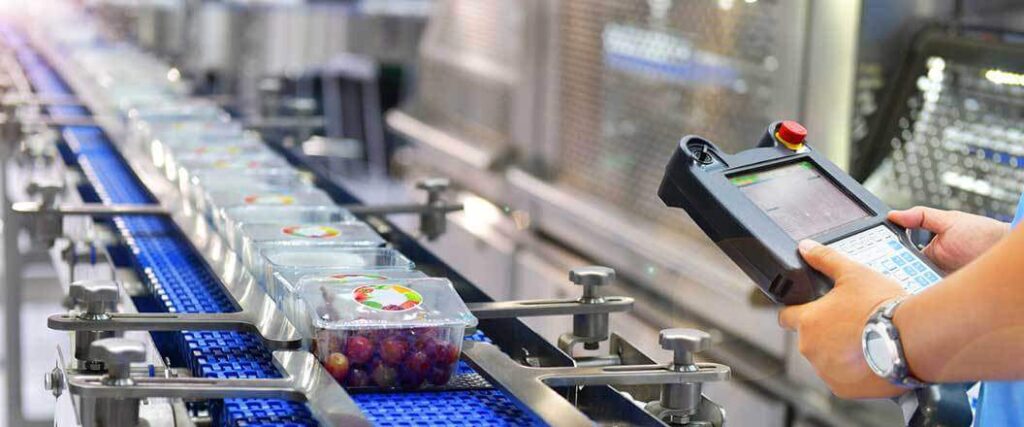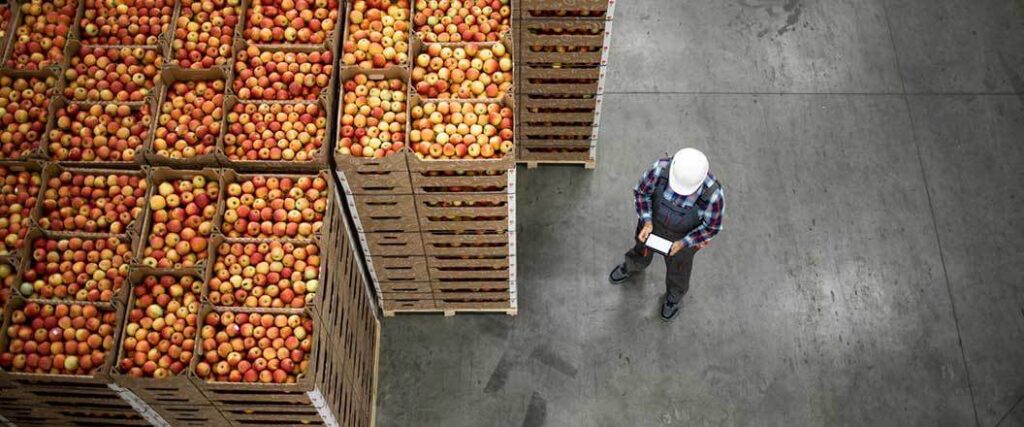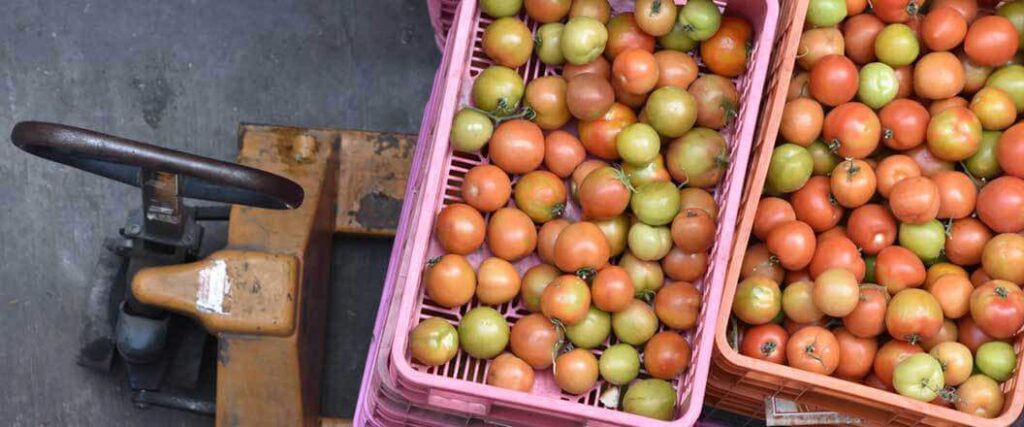Produce shipping costs are one crucial aspect that can’t be ignored when transporting fruit and vegetables. These expenses can pose significant challenges and put a strain on shippers. Managing the rates associated with transporting produce can be a daunting task and require careful consideration and planning.
According to the freight analytics company DAT, produce shipping costs are between $1.83 and $2.56 per mile. This amount can vary based on factors like fuel, distance, and seasonality. Some types of produce can also be transported using a dry van trailers. Rates for these two ground shipping options are slightly different.
It’s essential that businesses accurately budget for produce shipping costs. We’ll show you what to be aware before you send your shipment off.
Providing an amount that represents the average cost of shipping produce is difficult to do. Every shipment of fruits and vegetables is different, which causes prices to fluctuate. That said, shippers can determine how much it costs to ship produce by looking at reefer rates in different regions of the country.
| Region | Rate |
| West | $2.32 |
| Midwest | $2.56 |
| Northeast | $2.05 |
| Southeast | $2.44 |
| Southwest | $2.50 |
It's important to note that these figures are averages for each region. Some produce is transported by dry van trailers instead of by reefer. Rates for this type of transport can range between $1.83 and $2.20. Shipper should keep in mind that these costs can fluctuate over time.

The cost of shipping produce is can vary due to factors affecting every load. Clients in the agriculture and food industries need to understand these elements to make informed decisions and effectively manage their transportation budget.
The main factors that can impact produce shipping costs include:
Analyzing these variables will help businesses develop effective cost management strategies. We’ll explain each in the following sections.
The distance between the origin and destination plays a significant role in determining produce shipping costs. Transporting fruits and vegetables longer distances consumes more fuel. This results in higher shipping expenses.
Another factor to consider is that produce is perishable. Fruit and vegetable transports have to be performed very quickly. Overnight produce shipping fees might be neededto move these goods over a long distance in a short period of time.
The volume of produce being transported affects the overall costs. Food shipping costs are fixed. Therefore, a larger load of produce generally results in more cost-efficient transportation, while smaller loads are more expensive.
Businesses with small amounts of produce should consider consolidating their shipments when possible. Doing so combines the size of two loads into a larger one that will be more efficient to transport.
Packaging requirements have an impact on produce shipping costs. Proper packing ensures the safety and quality of the produce during transit, but it can also increase shipping costs.
The type of packaging materials used can include:
Fortunately, the cost of boxes for produce shipping isn’t too high. Pallets will be the most expensive material needed for a bulk shipment of fruits and vegetables.
Shippers can even use a combination of these packing materials. For example, they could use produce shipping boxes to hold their fruits and vegetables. After boxing and palletizing their items up, they can palletize their entire shipment. Additional costs might be incurred when shippers purchase other packing supplies.
Seasonality has a significant impact on the cost of shipping fresh produce. Certain fruits and vegetables are available during certain parts of year. We’ve provided a table that shows the harvest seasons for certain types of produce and vegetable.
| Spring | Summer | Fall | Winter |
| Apples | Apples | Broccoli | Brussels Sprouts |
| Bananas | Beets | Cabbage | Celery |
| Broccoli | Cherries | Mushrooms | Collard Greens |
| Cabbage | Eggplant | Pears | Grapefruit |
| Carrots | Beans | Pumpkins | Herbs |
| Kiwi | Mangos | Swiss Chard | Leeks |
| Lemons | Okra | Spinach | Onions |
| Lettuce | Peaches | Turnips | Oranges |
| Limes | Plums | Radishes | Rutabagas |
Some produce is available during multiple seasons. That said, the demand for certain kinds of fruit and vegetables will rise, which increases competition for transportation services. Prices are higher during these times, which means shippers will need to plan their shipments accordingly.
Finally, recall that different parts of the country go through their seasons at different times. This also means that peak harvest seasons will vary.
Finally, fuel prices directly affect the fresh produce shipping costs. When gas is on the rise, carriers often pass on these costs to shippers through fuel surcharges. This rule typically applies to all types of freight.
However, fruits and vegetables need to be transported quickly due to expiration dates. Expedited shipping along with high fuel prices can increase produce freight rates exponentially.

Preparing bulk shipments of fruit for transport requires following a set of steps. The slightest disturbance to fruit and vegetables during the shipping process can cause them to go bad or be destroyed.
Fortunately, there are a few procedures shippers can follow to prevent this:
Each of these methods ensure that fruits and vegetables will arrive at their destination in excellent condition. If these products aren’t prepared carefully, it could increase the amount of produce shipping costs that will have to be paid.
Before shipping, it’s crucial to sort and grade the produce to ensure consistency and quality. This requires shippers to follow a few simple steps.
Sorting and grading produce is done by:
Grading assigns a quality or classification to the sorted produce. The standards senders have to go by is usually determined by industry standards and customer requirements. Once sorting and grading has been completed, shippers can move onto the next step.
Choosing the right packaging materials is vital for protecting produce during transportation.
Using the appropriate practices can help protect fruits and vegetables while in transit. In some cases, following the correct packaging techniques can even prevent produce from spoiling.
Before packing, shippers should obtain some of these protective materials:
These materials will keep produce from being damaged by hard impacts. Once these materials are obtained, shippers can move on with packing their goods. This is done simply by putting produce into the boxes or crates used to hold them.
Shippers should securely seal packaging after placing produce into each container. This will prevent moisture intrusion and maintain the desired humidity levels. Once containers are sealed, shippers can move onto palletizing their bulk load of produce.
The last step is to clearly label the packaging with essential information and provide the correct documentation for the shipment. This part of the preparation process should be completed very carefully. Clear and accurate labeling is crucial for efficient transportation and compliance with regulations.
Each package should have the following information:
Labels will provide carriers with the relevant information they’ll need to transport produce correctly and safely. Next, shippers will need to obtain and use the correct documentation for their bulk load of produce.
Required shipping documents should include:
These types of paperwork will contain important information that receivers and carriers will use. Shippers should also keep records of labels and documentation for future reference. This might be useful during audits or for quality control purposes.
Some produce has to be shipped in a reefer trailer, while others can be transported in a dry van. Our article on reefer truck vs dry vans will show you which one is best for your food shipment.

Produce is highly perishable and sensitive to temperature fluctuations. Carriers play a vital role in maintaining the freshness of fruit and vegetables during transit. Many reefer trailers and trucks are equipped with advanced refrigeration technologies that help wth fresh produce shipping. Additionally, carriers use specialized loading and unloading techniques to protect fruit and vegetable shipments.
Refrigerated carriers use a few different transport options to accommodate produce shipments. However, most ground shipments that are moved over the road use one of two methods.
These include:
For bulk shipments, produce is typically transported using a reefer trailer hauled by a semi. They can come in various sizes and configurations that can accommodate different volumes of freight.
Reefer trailers can range in length from 28 to 53 feet and typically have a width of around 8.5 feet. These types of hauling equipment are equipped with advanced cooling systems that enable precise temperature control.
A reefer can maintain a wide range of temperatures, usually ranging from -20 degrees Fahrenheit to 70 degrees Fahrenheit. This trailer is able to obtain these temperatures thanks to a unit on their exterior.
The device has the following components:
Shippers of produce can trust that their bulk load of fruits and vegetables will be transported with care. Dry van trailers are an alternative to reefers. However, this option will only work if a shipper is sending produce that isn’t temperature sensitive. A dry van trailer typically has the same dimensions as a reefer, which allow it to carry a considerable amount of freight.
Moving produce in or off a reefer trailer must be done very carefully. There are three main ways that carriers protect fruits and vegetables when completing these processes.
They include:
Handling produce carefully is one of the most important parts of loading or unloading freight. One way carriers do this is by arranging the produce in a way that allows it to receive proper airflow. Bulk shipments also need to be handled with the appropriate equipment.
This includes:
It’s crucial to monitor and maintain the desired temperature and humidity levels while produce is in transit. Carriers conduct checks to ensure that the conditions remain within the specified range.
Temperature fluctuations can have a detrimental impact on the quality of the produce. Additionally, carriers avoid frequent opening of trailer or warehouse doors to minimize these changes.
Let USA Refrigerated Freight be your trusted partner when shipping your valuable produce. With our extensive experience and commitment to excellence, your fruits and vegetables will arrive at the final destination safely and on time. We also offer a range of services designed to meet your specific needs.
Some of our services include:
At USA Refrigerated Freight, we can secure transport for your shipment of fruits and vegetables. Fill out your quote if you’re ready to secure transport for your shipment of produce. Our team is also available at (866) 849-2713 if you have any questions or require more information.
USA Refrigerated Freight
315 NE 14th Street #4122
Ocala, FL 34470